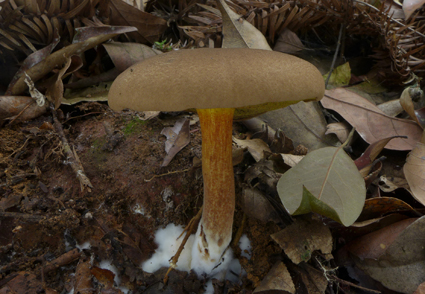Abstract
Species of Boletellus Section Chrysenteroidei are widely distributed in the world, especially in the subtropical to tropical regions. By means of molecular techniques, the species diversity of this section has become clearer and new taxa have been uncovered. In this study, a new species of this section from the southeast Yunnan of China, namely Boletellus wenshanensis, was identified based on molecular and morphological evidence. This species can be distinguised by the combination of morphological characters: a quick dark blue reaction on all parts of the basidiome when bruised, a brown to brownish orange pileus uncracking with age, a scaly stipe covered with brownish punctate squamules, yellow hymenophore, interwoven pileipellis, ellipsoid to broadly fusoid basidiospores ornamented with longitudinal ridges, and a hyphohymeniform stipitipellis. The new species is presented with illustrated description and comparisons with allied species.
References
Fulgenzi, T.D., Mayor, J.R., Henkel, T.W. & Halling, R.E. (2008) New species of Boletellus from Guyana. Mycologia 100 (3): 490–495. https://doi.org/10.3852/07-170R
Hall, T.A. (1999) BioEdit: a user-friendly biological sequence alignment editor and analysis program for Windows 95/98/NT. Nucleic Acids Symposium Series 41: 95–98.
Hongo, T. & Izawa, M. (1994) Yama-Kei Field Book on Mushrooms. Yama-Kei Publishers Co. Ltd., Tokyo.
Horak, E. (1977) Boletellus and Porphyrellus in Papua New Guinea. Kew Bulletin 31 (3): 645–652. https://doi.org/10.2307/4119416
Katoh, K. & Standley, D.M. (2013) MAFFT Multiple sequence alignment software version 7: Improvements in performance and usability. Molecular Biology and Evolution 30 (4): 772–780. https://doi.org/10.1093/molbev/mst010
Kornerup, A. & Wanscher, J.H. (1981) Taschenlexikon der Farben, 3rd edn. Aufl. Göttingen: Muster-Schmidt Verlag.
Lanfear, R., Frandsen, P.B., Wright, A.M., Senfeld, T. & Calcott, B. (2017) PartitionFinder 2: New methods for selecting partitioned models of evolution for molecular and morphological phylogenetic analyses. Molecular Biology & Evolution 34 (3): 772–773. https://doi.org/10.1093/molbev/msw260
Li, Y.-C., Yang, Z.-L. & Bau, T. (2009) Phylogenetic and biogeographic relationships of Chroogomphus species as inferred from molecular and morphological data. Fungal Diversity 38: 85–104.
Mayor, J.R., Fulgenzi, T.D., Henkel, T.W. & Halling, R.E. (2008) Boletellus piakaii sp. nov. and a new distribution record for Boletellus ananas var. ananas from Guyana. Mycotaxon 105: 387–398.
Nuhn, M.E., Binder, M., Taylor, A.F.S., Halling, R.E. & Hibbett, D.S. (2013) Phylogenetic overview of the Boletineae. Fungal Biology 117 (7–8): 479–511. https://doi.org/10.1016/j.funbio.2013.04.008
Ortiz-Santana, B., Lodge, D.J., Baroni, T.J. & Both, E.E. (2007) Boletes from Belize and the Dominican Republic. Fungal Diversity 27: 247–416.
Parihar, A., Hembrom, M.E., Vizzini, A. & Das, K. (2018) A new species of Boletellus (Boletaceae, Basidiomycota) from tropical India. Nordic Journal of Botany 36. https://doi.org/10.1111/njb.02089
Ronquist, F., Teslenko, M., Van Der Mark, P., Ayres, D.L., Darling, A., Höhna, S., Larget, B., Liu, L., Suchard, M.A. & Huelsenbeck, J.P. (2012) MrBayes 3.2: efficient Bayesian phylogenetic inference and model choice across a large model space. Systematic Biology 61 (3): 539–542. https://doi.org/10.1093/sysbio/sys029
Singer, R. (1945) The Boletineae of Florida with notes on extralimital species. I. Strobilomycetaceae. Farlowia 2 (1): 97–141. https://doi.org/10.5962/p.316006
Smith, A.H. & Thiers, H.D. (1971) The boletes of Michigan. University of Michigan Press, Ann Arbor.
Smith, S.A. & Dunn, C.W. (2008) Phyutility: a phyloinformatics tool for trees, alignments and molecular data. Bioinformatics 24 (5): 715–716. https://doi.org/10.1093/bioinformatics/btm619
Snell, W.H. (1936) Notes on boletes. V. Mycologia 28 (5): 463–475. https://doi.org/10.1080/00275514.1936.12017161
Snell, W.H. (1941) The genera of the Boletaceae. Mycologia 33 (4): 415–423. https://doi.org/10.2307/3754896
Stamatakis, A. (2014) RAxML version 8: a tool for phylogenetic analysis and post-analysis of large phylogenies. Bioinformatics 30 (9): 1312–1313. https://doi.org/10.1093/bioinformatics/btu033
Thiers, B. (2020) Index Herbariorum: A global directory of public herbaria and associated staff. New York Botanical Garden’s Virtual Herbarium. Available from: http://sweetgumnybgorg/science/ih/ (accessed 18 May 2022)
Vadthanarat, S., Raspé, O. & Lumyong, S. (2018) Phylogenetic affinities of the sequestrate genus Rhodactina (Boletaceae), with a new species, R. rostratispora from Thailand. Mycokeys 29: 63–80. https://doi.org/10.3897/mycokeys.29.22572
Wen, H.-A. (1985) New species and new records of genus Boletellus from China. Acta Mycologica Sinica 4 (4): 222–226.
Wu, G., Feng, B., Xu, J.-P., Zhu, X.-T., Li, Y.-C., Zeng, N.-K., Hosen, M.I. & Yang, Z.-L. (2014) Molecular phylogenetic analyses redefine seven major clades and reveal 22 new generic clades in the fungal family Boletaceae. Fungal Diversity 69: 93–115. https://doi.org/10.1007/s13225-014-0283-8
Wu, G., Li, Y.-C., Zhu, X.-T., Zhao, K., Han, L.-H., Cui, Y.-Y., Li, F., Xu, J.-P. & Yang, Z.-L. (2016) One hundred noteworthy boletes from China. Fungal Diversity 81: 25–188. https://doi.org/10.1007/s13225-016-0375-8
Zang, M. (1985) Notes on the Boletales from eastern Himalayas and adjacent of China. Acta Botanica Yunnanica 7 (4): 383–401.
Zang, M., Chen, S.M. & Sittigul, C. (1999) Some new and interesting taxa of Boletales from tropical Asia. Fungal Science 14 (1–2): 19–25.
Zhang, W., Wang, D., Yang, S.-F., Long, C.-H., Wang, L., Zhu, W., Jiang, S.-W. & Yan, Z.-H. (2011) The characteristics of weather and climate in Wenshan and the focus of severe weather forecast (in Chinese). Yunnan Geographic Environment Research 23: 77–81.


